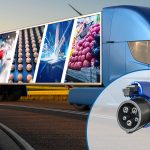6 Steps To Making Your Fleet Carbon Neutral
Fleet companies throughout the supply chain are taking bold steps toward reaching carbon neutrality. And operating a carbon-neutral operation will be a key strategy to secure large contracts, investments as well as acquire and retain talents. As a fleet manager, these goals are going to affect you the most, because a fleet is typically one of the biggest sources for carbon that needs to be reduced.
Here are the 6 steps fleet companies should follow to go from carbon-heavy to carbon neutral:
Step 1: Figure Out Where You Are Today
The first step in any reduction plan is to find out where you are. Based on the number of vehicles in your fleet, the age of your fleet, and the miles driven per year alone, you can get a realistic picture of the amount of carbon you generate today. Carbon neutrality is about ALL of the carbon you produce throughout your operation, your fleet of vehicles, the maintenance areas, the distribution centers, the corporate office, any regional offices… all of it. So you should look at your electric consumption, the amount of waste you generate…It all counts.
Step 2: Develop And Communicate A Detailed Plan
Once you understand the carbon you are producing, whether just for your fleet or throughout the entire supply chain you manage, you need to establish meaningful emission reduction goals along with specific milestones. Carbon neutrality is a process that takes time, your employees, shareholders, and customers need to know that what voluntary carbon reduction strategies you are deployment going into the transition. They also need to understand the importance of carbon neutrality.
Step 3: Start With The Fleet Operation
Logistics and efficiency already go hand in hand, but to achieve carbon neutrality – you’ve got to go that extra mile. Some of the main tools to reduce the carbon emissions of your fleet can include the following for example:
- Routing Software: Inefficient routing is responsible for the bulk of the wasted fuel and time that a fleet will experience. All those extra miles equal extra emissions. Using technology to really hone your routing and efficiency can go a long way toward carbon neutrality. There are countless software suites out there that offer efficient, automated routing so take the time to pick one that works best for your operation. Technology upgrades can seem like daunting projects, but in the long run, they can save you more money in the end.
- Fuel-Efficiency/Emissions Upgrades to Fleet: Auto manufacturers are always improving the efficiency and emission output of their vehicles. The same is true for the availability of aftermarket products that can be used to enhance your fleet’s performance. Spending the money on upgrading an existing fleet can help avoid the huge up-front cost of replacing vehicles across the board. There are a lot of large fleets pledging to be emission-free by as soon as 2030, but that is a process that can be done in baby steps. Often times, the money saved in fuel and carbon credits that would otherwise have to be purchased can easily offset the expenses associated with these upgrades. PedalCoach, for instance, is a simple device that helps truck drivers achieve greater fuel efficiency by monitoring their driving habits. Think of it as a FitBit, but for the gas pedal. Companies can monitor and reward drivers for increased fuel efficiency.
- Maintenance: Regularly scheduled maintenance is critical to fleet efficiency. It can also be the thorn in any fleet operator’s side because you have to take a vehicle off of the road to get it maintained, however, it is time well spent to decrease the risk of costly unplanned repairs and to extend the life of your assets. Little things like monitoring tire pressure can go a long way to making a fleet more carbon friendly.
Step 4: The Key Accelerator: Reduce Your Waste Footprint
When working toward a carbon-neutral fleet operation, it is easy to get tunnel vision and only focus on the vehicles. The real key to carbon neutrality is in ALL the waste you produce. Keep in mind: wasted materials equal wasted money.
Used tires, pallets, construction and renovation waste, hazardous waste, electronic waste, and all waste fluids all play a part in contributing to a fleet carbon footprint and need to be reduced.
Recycling makes carbon neutrality a lot easier to achieve and it positively impacts your bottom line in three different ways: recycling reduces the amount you spent to send waste to the landfill, creates revenue streams and significantly reduces the amount you will need to spend on carbon credit.
An “average” ton of waste diverted from the landfill reduces an estimated 2.5 metric tons of CO2 emissions. That’s 2.5 metric tons of emissions that you don’t have to buy carbon credits for.
Start with the waste streams that are easiest to divert and work your way to the more difficult ones. Your waste minimization company becomes extremely important in this phase, so choose wisely.
Step 5: Offset What Cannot Be Eliminated With Carbon Credits
Once you’ve gotten your fleet running like a well-oiled machine, and you optimized your recycling programs, the last step to achieve carbon-neutral is purchasing carbon credits, or “offsets”. Offsets typically take the shape of financial support for projects that reduce the emission of greenhouse gases in the short or long term. The most common format is a renewable energy project, such as wind farms, biomass energy or hydroelectric dams. Others include energy-efficiency projects, forestry projects, the destruction of industrial pollutants or agricultural by-products, and the destruction of landfill methane. Two of the most popular types of carbon offset projects from a corporate perspective are energy efficiency and wind turbine projects.
Step 6: Track and Report
Carbon neutral operation is a multiyear transformation that requires constant measurement, tracking and reporting.
Measure the carbon reduction year after year and compare it to the goals. Measure your company-wide greenhouse gas emissions – by scope, by source, by operation or by process.
Track the carbon reduction associated with each reduction initiative and compare it with the initial estimates. Track any setback, identify the root cause and the corrective action taken, then track the impact that the improved initiative. Track employee engagement, ideas, and suggestions.
Report annually your achievements for all your stakeholders ( customers, investors, employees.) to view. As well as submit your results to the carbon disclosure project for example or other renowned platforms.









